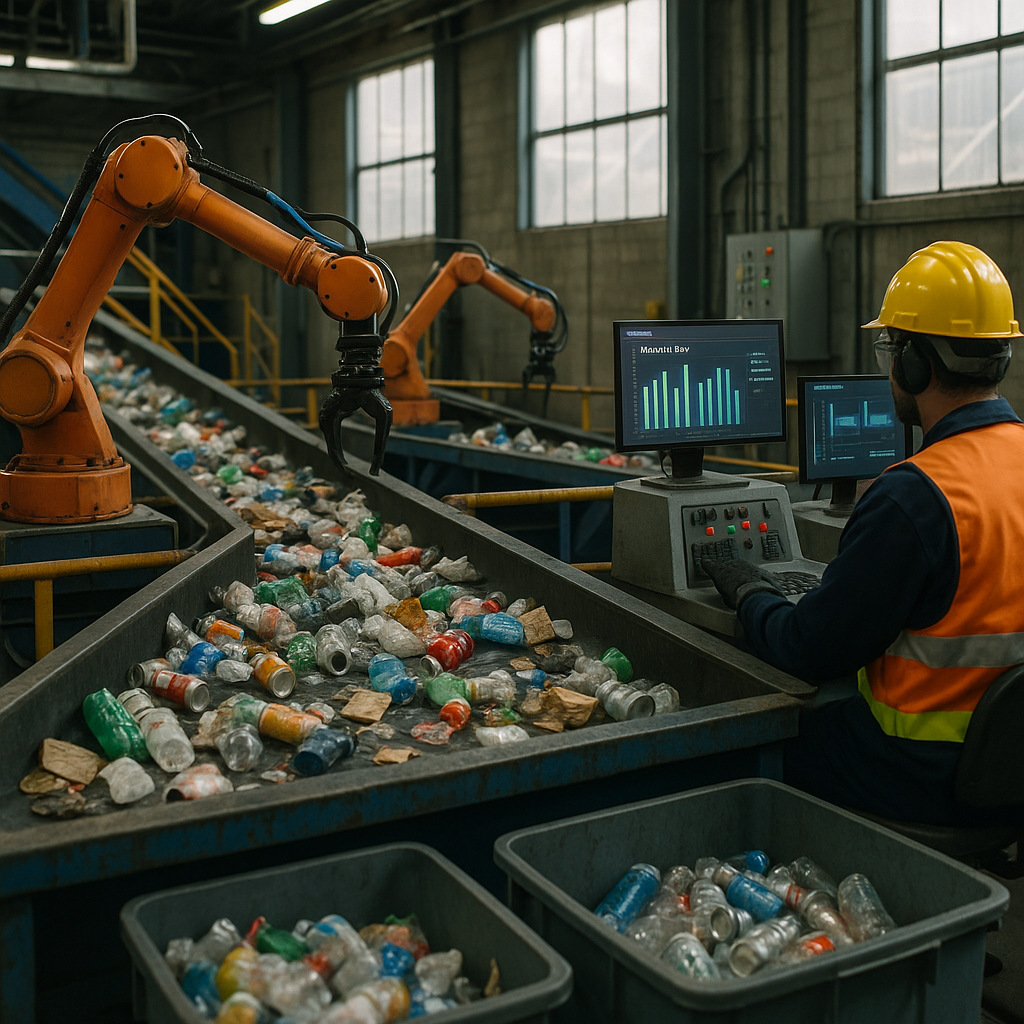5901 Botham Jean Blvd, Dallas, TX 75215
How AI, Robotics, and Chemical Recycling Are Revolutionizing Waste Management
July 10, 2025Every year, humans generate over 2 billion tons of municipal solid waste, with projections indicating this could rise to 3.4 billion tons by 2050. This staggering volume highlights the urgent need for more effective recycling solutions. Fortunately, groundbreaking technological innovations are transforming how we process and reclaim materials from our waste stream.
Recycling technologies have evolved significantly in recent years, moving beyond simple mechanical sorting to adopt sophisticated digital systems. These advancements create more efficient, cost-effective, and environmentally friendly waste management methods that promise to reduce landfill use and conserve valuable resources.
Three major technological breakthroughs are at the forefront of this recycling transformation. Advanced sorting systems powered by artificial intelligence and machine learning can now identify and classify materials with remarkable precision. Chemical recycling processes offer new ways to break down complex plastics previously considered non-recyclable. Additionally, automated robotics are advancing waste collection and sorting operations, improving both efficiency and worker safety throughout the recycling chain.
How is AI Transforming Recycling Processes?

Artificial intelligence and machine learning have reshaped recycling practices. Vision AI systems now sort materials with unparalleled precision, employing sophisticated algorithms to recognize items instantly based on visual traits.
Traditional manual sorting handles 30-40 items per minute with accuracy rates around 65-80%. In contrast, AI-powered optical sorting systems manage up to 200 items per minute with accuracy exceeding 95%. This significant improvement derives from computer vision technologies detecting subtle material differences that human sorters may overlook.
AI-Powered Optical Sorting Systems
Modern recycling facilities use vision AI systems equipped with high-resolution cameras and near-infrared sensors to scan waste materials on conveyor belts. The system identifies items in a split second, based on shape, size, color, and material composition.
Robotic arms integrated with these systems physically separate identified materials. They distinguish between various plastic polymers, metals, paper grades, and even contaminated materials—capabilities absent in previous sorting technologies.
Facilities employing AI report significant capacity and efficiency improvements. A single AI-powered line can replace multiple traditional sorting stations, delivering superior results.
Key Benefits of AI in Recycling
- Higher recovery rates – AI systems identify recyclable materials that might be missed by human sorters
- Reduced contamination – More accurate sorting leads to purer material streams
- Increased processing speed – AI systems work continuously without fatigue
- Lower operational costs – Automation reduces labor requirements
- Adaptability – Machine learning enables systems to improve over time and adjust to new material types
The introduction of AI in recycling tackles one of the industry’s persistent issues: contamination. Non-recyclable materials mixed with recyclables can render entire batches unusable. AI significantly mitigates this by detecting contaminants with remarkable accuracy.
Materials recovery facilities (MRFs) using AI report contamination reductions from 15-25% down to just 5%. This leads to higher-quality recovered materials that fetch better market prices and see greater demand from manufacturers.
Beyond sorting, AI systems gather valuable data on waste composition. This information aids facilities in optimizing processes and provides municipalities with insights into waste trends, enabling them to adjust operations as necessary.
[[artifact_table]] Comparison of Traditional vs. AI-Powered Recycling Sorting Methods [[/artifact_table]]In e-waste processing, AI systems pinpoint valuable components for recovery, such as precious metals and rare earth elements in electronic devices. This ability maximizes resource recovery from increasingly complex waste streams.
What Breakthroughs are Happening in Chemical Recycling?

Chemical recycling offers a transformative approach to managing plastic waste. Unlike traditional mechanical recycling, which reshapes plastics by melting them, chemical recycling breaks materials down at the molecular level. Consider it as breaking a LEGO structure back into its individual blocks rather than merely reshaping the entire structure.
The industry has witnessed significant advancements in two main processes: depolymerization and pyrolysis. Depolymerization reverts plastics to their original building blocks or monomers. This is particularly effective for polyester plastics like PET, commonly found in beverage bottles and food containers. Recent innovations include a binuclear complex catalyst that breaks down not just PET, but also other polymers like Nylon 66 and polylactic acid.
Another remarkable breakthrough is enzymatic depolymerization. Scientists have developed specialized enzymes that decompose plastic polymers in moderate conditions without relying on harsh chemicals. One team successfully engineered fusion proteins combining robust cutinase with esterase enzymes, significantly enhancing PET breakdown efficiency.
Pyrolysis technology has also progressed considerably. This process thermally degrades plastic waste in an oxygen-free environment, converting it into oils, gases, and char. Modern pyrolysis facilities use in-situ hydrogenation to increase alkane production and improve the quality of the resulting fuels or feedstocks.
A noteworthy development is the integration of these technologies with renewable energy. Small-scale, decentralized pyrolysis plants now utilize on-site water electrolysis powered by solar or wind energy to produce the hydrogen required for the process, making the system more sustainable and reducing its carbon footprint.
The true value of these chemical recycling innovations lies in their ability to process plastics that mechanical recycling cannot handle. Multi-layered packaging, contaminated plastics, and mixed plastic waste streams that typically end up in landfills or incinerators can now be transformed into valuable resources. For example, a small-scale pyrolysis plant processing 165 kg per hour can convert mixed plastic waste into naphtha, an alternative to virgin petroleum feedstock in plastic production.
These technologies are particularly promising for challenging plastics to recycle, such as polystyrene foam, plastic films, and food-contaminated containers. By breaking these materials down to their molecular components, chemical recycling fosters a genuinely circular economy for plastics, where even the most problematic waste generates raw materials for new products.
While challenges remain in scaling these technologies and reducing their energy requirements, the advances in chemical recycling mark a significant step toward resolving the global plastic waste crisis. Industry leaders like BASF, Plastic Energy, and Loop Industries are already implementing these advanced recycling methods at commercial scales, demonstrating their viability as essential components of sustainable waste management.
How are Smart Technologies Improving Waste Management?
Smart waste management systems are transforming how cities and companies handle waste collection and recycling. These systems use IoT (Internet of Things) devices, sensors, and advanced data analytics to optimize every phase of the recycling lifecycle, creating more sustainable and cost-effective waste management solutions.
Smart bins equipped with fill-level sensors are a significant innovation in this field. These sensors monitor waste accumulation in real-time and communicate wirelessly when bins reach capacity. This capability greatly enhances waste collection efficiency. Instead of following fixed schedules that might lead to emptying half-full bins or missing overflowing ones, collection teams can now prioritize locations based on actual need.
The data collected from these smart bins extends beyond simple fill levels. Advanced analytics platforms process information about waste volume, composition, and disposal patterns across different locations and timeframes. This data enables municipalities and waste management companies to make informed decisions about resource allocation. For instance, if sensors indicate consistently high volumes of plastic waste in a particular commercial district, targeted recycling initiatives can be launched specifically for that area.
San Francisco provides an impressive example of smart waste management success. The city implemented a network of smart bins throughout downtown, optimizing collection routes using IoT technology. By analyzing the collected data, San Francisco reduced unnecessary collection trips by 66%, saving approximately $650,000 in annual fuel costs. The optimized routes also decreased traffic congestion and lowered carbon emissions from collection vehicles by an estimated 2,000 tons per year.
Route optimization is another key benefit of smart waste management. AI-powered algorithms analyze fill-level data alongside traffic patterns, vehicle capacity, and other variables to determine the most efficient collection paths. This reduces fuel consumption and operational costs while minimizing the environmental impact of waste collection fleets. Some cities have reported up to a 30% reduction in fuel usage after implementing smart routing systems.
Additionally, the data generated by smart waste management systems provides valuable insights into consumption patterns and waste generation trends. Municipalities can use this information to develop more effective recycling education campaigns and waste reduction initiatives tailored to specific neighborhoods or business districts. The ability to measure the success of these programs through concrete data allows continuous improvement and refinement of waste management strategies.
Beyond collection efficiency, smart technologies are enhancing sorting and processing capabilities at recycling facilities. AI-powered optical sorting systems can identify and separate different types of recyclable materials with greater accuracy than manual sorting, increasing the recovery rate of valuable materials like plastics, metals, and paper products.
As these technologies evolve, more sophisticated applications are expected, such as predictive analytics that anticipate waste generation spikes during special events or seasonal changes, allowing waste management teams to proactively adjust their resources and strategies.
Through integrating smart technologies, waste management is moving from a reactive, schedule-based service to a dynamic, data-driven system that maximizes efficiency while minimizing environmental impact.
What is the Future of Recycling Technology?

The future of recycling technology holds great potential with ongoing innovations in waste management. Advanced sorting technologies using artificial intelligence and machine learning are transforming material processing. These systems can identify and separate recyclables with exceptional accuracy and speed, significantly reducing contamination and increasing recovery rates.
Chemical recycling is another promising development, breaking down plastics into their molecular components for reuse in new products. This technology tackles previously challenging materials to recycle and fosters truly circular pathways for plastics. Additionally, blockchain applications are enhancing supply chain transparency, enabling materials to be tracked from collection through processing and into new products. This transparency builds trust and accountability within the recycling ecosystem.
The waste management industry is also advancing rapidly in waste-to-energy technologies that convert non-recyclable materials into clean power. These systems are becoming more efficient and environmentally friendly, providing solutions for materials that cannot be mechanically recycled. Furthermore, innovative product designs featuring easily recyclable materials are gaining traction as manufacturers adopt sustainability principles.
These technological breakthroughs, combined with growing environmental awareness and increasingly stringent regulations, are transforming our approach to waste. Rather than viewing discarded items as worthless, we are recognizing them as valuable resources in a circular economy. The future involves not only improved recycling technology but also a fundamental shift in how we perceive materials and waste. For your recycling needs, contact Okon Recycling at 214-717-4083.
